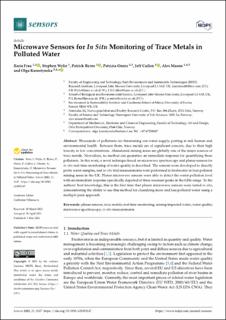| dc.contributor.author | Frau, Ilaria | |
| dc.contributor.author | Wylie, Stephen | |
| dc.contributor.author | Byrne, Patrick | |
| dc.contributor.author | Onnis, Patrizia | |
| dc.contributor.author | Cullen, Jeff | |
| dc.contributor.author | Mason, Alex | |
| dc.contributor.author | Korostynska, Olga | |
| dc.coverage.spatial | United Kingdom | en_US |
| dc.date.accessioned | 2021-05-11T11:19:33Z | |
| dc.date.available | 2021-05-11T11:19:33Z | |
| dc.date.created | 2021-05-07T09:37:03Z | |
| dc.date.issued | 2021-05-01 | |
| dc.identifier.citation | Sensors. 2021, 21 (9), 3147-1-3147-26. | en_US |
| dc.identifier.issn | 1424-8220 | |
| dc.identifier.uri | https://hdl.handle.net/11250/2754868 | |
| dc.description.abstract | Thousands of pollutants are threatening our water supply, putting at risk human and environmental health. Between them, trace metals are of significant concern, due to their high toxicity at low concentrations. Abandoned mining areas are globally one of the major sources of toxic metals. Nowadays, no method can guarantee an immediate response for quantifying these pollutants. In this work, a novel technique based on microwave spectroscopy and planar sensors for in situ real-time monitoring of water quality is described. The sensors were developed to directly probe water samples, and in situ trial measurements were performed in freshwater in four polluted mining areas in the UK. Planar microwave sensors were able to detect the water pollution level with an immediate response specifically depicted at three resonant peaks in the GHz range. To the authors’ best knowledge, this is the first time that planar microwave sensors were tested in situ, demonstrating the ability to use this method for classifying more and less polluted water using a multiple-peak approach | en_US |
| dc.description.sponsorship | The authors gratefully acknowledge the support of Liverpool John Moores University, the Faculty of Engineering and Technology in conjunction with the Faculty of Science PhD Scholarship Programme which allowed this research to be undertaken. | en_US |
| dc.language.iso | eng | en_US |
| dc.publisher | MDPI | en_US |
| dc.relation.ispartofseries | Sensors;21 (9) | |
| dc.rights | Navngivelse 4.0 Internasjonal | * |
| dc.rights.uri | http://creativecommons.org/licenses/by/4.0/deed.no | * |
| dc.subject | Planar sensors | en_US |
| dc.subject | Toxic metals | en_US |
| dc.subject | Real-time monitoring | en_US |
| dc.subject | Mining-impacted water | en_US |
| dc.subject | Water qualities | en_US |
| dc.subject | Microwave spectroscopy | en_US |
| dc.subject | In situ measurements | en_US |
| dc.title | Microwave Sensors for In Situ Monitoring of Trace Metals in Polluted Water | en_US |
| dc.type | Journal article | en_US |
| dc.type | Peer reviewed | en_US |
| dc.description.version | publishedVersion | en_US |
| dc.rights.holder | © 2021 by the authors. | en_US |
| dc.source.articlenumber | 3147 | en_US |
| cristin.ispublished | true | |
| cristin.fulltext | original | |
| cristin.qualitycode | 1 | |
| dc.identifier.doi | https://doi.org/10.3390/s21093147 | |
| dc.identifier.cristin | 1908669 | |
| dc.source.journal | Sensors | en_US |
| dc.source.volume | 21 | en_US |
| dc.source.issue | 9 | en_US |
| dc.source.pagenumber | 26 | en_US |

